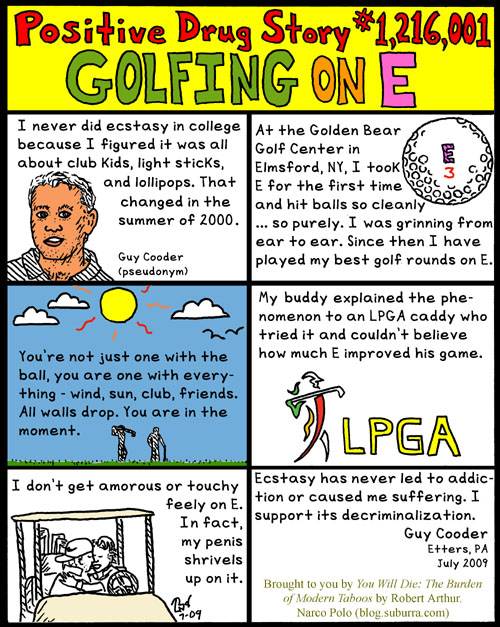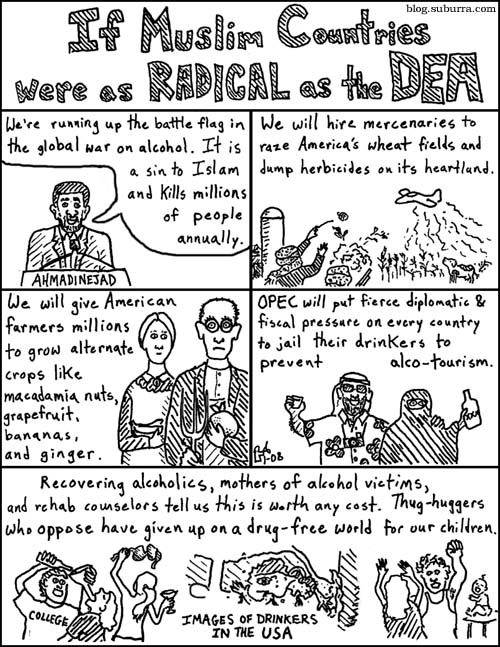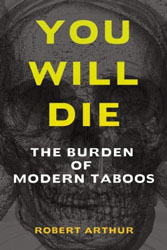Posted: July 15th, 2009 | Filed under: alcohol, DEA, drugs, heroin, history, opiates | 4 Comments »

In 1973 President Richard Nixon created the Drug Enforcement Administration (DEA) claiming there was a junkie explosion with eight times as many heroin addicts as two years earlier (a lie), and that drugs were “decimating a generation of Americans.” At the time, far more Americans were dying from choking on food or falling down stairs. (Baum, pp. 12, 28)
In reality, Nixon saw the DEA as a jurisdiction-free police force that would indirectly target blacks saying, “You have to face the fact that the whole problem is really the blacks. The key is to devise a system that recognizes this all while not appearing to.” (Baum, p. 13)
An assistant to Egil Krogh, a member of Nixon’s administration imprisoned in the Watergate scandal, explained, “If we hyped the drug problem into a national crisis, we knew that Congress would give us anything we asked for.” (Epstein, p. 140)
While president, Nixon would get drunk and pop pills from his private stash. He never had himself arrested.
Nixon’s statistical deceit regarding heroin addict numbers is explained in Agency of Fear: Opiates and Political Power in America. (pp. 174-177) When Nixon later wanted to show his War on Drugs was working the addict population was magically sliced by 25%.
The Nixon quotes are from Dan Baum’s Smoke and Mirrors: The War on Drugs and the Politics of Failure. Baum took the “blacks” quote from the diary of Nixon’s Chief of Staff, H.R. Haldeman. Another quote in Haldeman’s diary was that Nixon wanted to know “why all the Jews seem to be the ones that are for liberalizing the regulations on marijuana.” (p. 54)
Nixon’s generous use of drugs – prescribed and not prescribed (Dilantin) – and alcohol is detailed in Anthony Summers’ The Arrogance of Power: The Secret World of Richard Nixon.
* This post was updated on May 30, 2012.
Sources:
1. Robert Arthur, You Will Die: The Burden of Modern Taboos (2008).
2. Dan Baum, Smoke and Mirrors: The War on Drugs and the Politics of Failure (1996).
3. Edward Jay Epstein, Agency of Fear: Opiates and Political Power in America (1977).
4. Anthony Summers, The Arrogance of Power: The Secret World of Richard Nixon (2000).
Posted: July 11th, 2009 | Filed under: DEA, drugs, ecstasy, legalization, media bias | 2 Comments »

The biochemist, Alexander Shulgin, first reported MDMA’s beneficial effects in a journal article in 1978. MDMA, or ecstasy, creates empathy in its users and has exhibited great potential as a psychotherapy tool. Shulgin himself enjoyed using it to loosen up and relate to others at social gatherings.
Despite the fact psychologists and psychiatrists championed its value in therapy, when young adults started using it as a club drug in the 1980s the DEA made it a Schedule I Drug. This classification is supposed to be restricted to drugs with high abuse potential and no acceptable medical uses. [MDMA has no addiction potential. (Gahlinger, p. 338)] A DEA pharmacologist has admitted the DEA wasn’t even aware psychiatrists were using MDMA for treatment. In other words, they did not bother to research the drug before deciding to throw adults in prison for its possession.
The mass media proceeded to jump on the “all recreational drugs are evil” bandwagon by portraying ecstasy as a drug that leads kids to crazy casual sex and death. MDMA causes empathy not increased libido. The fallacy of it being a sex drug is obvious for many men as Cooder notes in the above cartoon. For the gross exagerration of its deadliness see the previous post, “Deadly Nuts: If Peanuts Were Portrayed Like E.”
As Jacob Sullum wrote in Saying Yes, “Like LSD, [MDMA] became illegal because too many people started to enjoy it.” (Sullum, p. 171)
To preempt MDMA destroys your brain comments, here is a link to Shulgin’s response and a 2006 journal article link disproving the brain damage theories.
Request for Positive Drug Stories
If you have a positive drug story that is either unique, humorous, or interesting; and are willing to have it told through illustrations please contact me at rob@suburra.com. Anonymity is respected.
Sources:
1. Paul Gahlinger, Illegal Drugs (2001).
2. Jacob Sullum, Saying Yes (2003).
Posted: February 1st, 2008 | Filed under: cocaine, DEA, drugs, heroin | 1 Comment »

Would We Stand For It?
1. In 1982 Ronald Reagan launched his disastrous war on drugs with the words, “We’re taking down the surrender flag that has flown over so many drug efforts. We’re running up a battle flag.”
2. In 2000 there were an estimated 85,000 alcohol related deaths in the United States alone. In 2005 there were 40,000 deaths from alcohol poisoning (alcohol overdose) in Russia alone.
3. Destroying drug crops in foreign lands was an idea conceived by the Reagan administration. Reagan hired mercenaries to clear the coca fields of poor Peruvian farmers with weed whackers. This was a farce considering coca grows naturally in Peru in valleys the size of Massachusetts. America is now waging this vegetative vendetta against poppies in Afghanistan.
4. America’s next plan was to aerially dump herbicides over the South American countryside. While officially targeting coca these toxins kill all plant life – including subsistance crops – while poisoning the environment and the local residents. This technique is still used in South America as a part of Plan Colombia. Afghanistan has understandably refused to allow the United States to dump herbicides on its countryside.
5. Another part of Plan Colombia is to pay farmers to plant crops other than coca. Like the previous two tactics, this has been comically ineffective as Bolivian farmers who switched to ginger learned when they found themselves, “up to their asses in ginger,” and nobody willing to buy it.
6. America uses its full diplomatic weight and financial power to bully other countries against liberalizing their drug laws. In 2006 America stopped Mexico’s legislation to legalize small amounts of drugs with a closed door meeting. The American position was that drug liberalization by Mexico would lead to narco-tourism for Americans. (America has an officer in most major foreign embassies charged with keeping Washington informed of any liberalization of drug policies.) How much America spends to coerce other countries to keep prosecuting their citizens is rarely revealed to the American public.
7. For thousands of years opium had been smoked as medicine in South Asia and coca has been chewed for sustenance in South America with miniscule deleterious effects. However, the American media portrays Afghanistan as a cesspool of addiction due to its easy access to opium. In articles such as Newsweek’s “Flowers of Destruction” and “Harvest of Treachery” moderate use of the drug is ignored and dysfunctional addicts who constitute a microscopic percentage of the population are highlighted. (The fact that the drug war drives people to use harder versions of the drug is always ignored. This recently occurred in rural Laos where an opium crackdown precipitated by immense Western pressure drove many tribespeople to heroin.)
More on Plan Colombia can be found in a Nation article, LINK, and at Wikipedia, LINK. The ongoing billion dollar program has killed a lot of flora, provoked massive amounts of bloodshed with American provided weaponry, and caused deep American resentment. It has not affected cocaine prices in the United States.
Sources:
- “Alcohol Deaths Falling as Quality of Booze Climbs,” Moscow Times, 29 Jan. 2008. LINK courtesy of ViceSquad.
- Robert Arthur, You Will Die: The Burden of Modern Taboos (2007). LINK
- Mike Gray, Drug Crazy (1998). LINK
- Phillip Knightley, “What Went Wrong? The Drugs World War: Part Two,” Independent (London), 1 Feb. 1998.
- “Laos’s Opium Ban,” Economist, 13 Aug. 2005.





